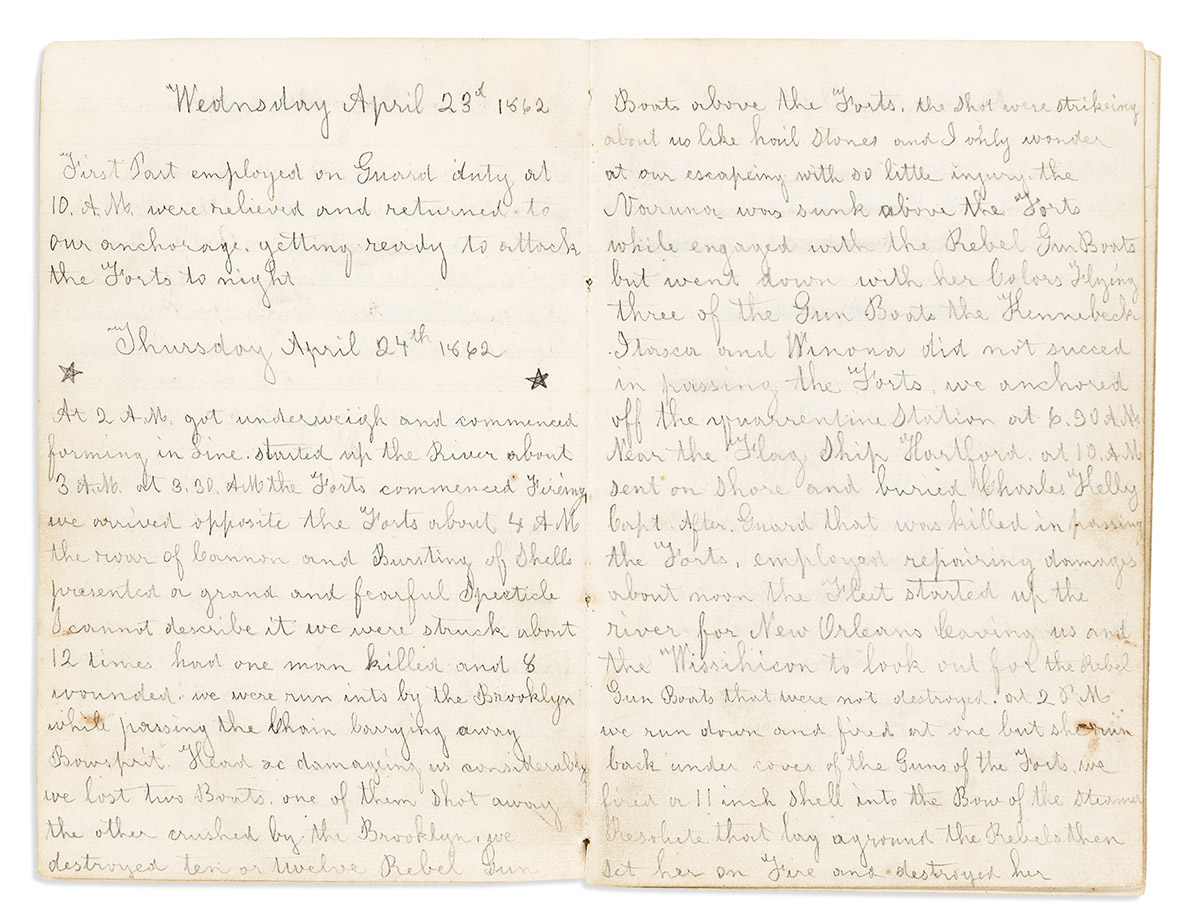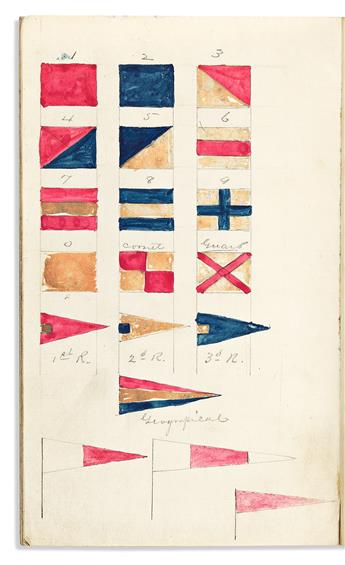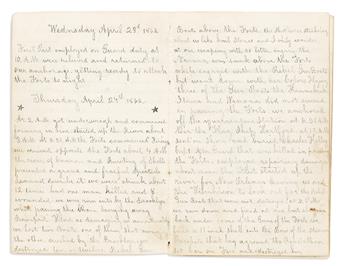Sale 2646 - Lot 134
Price Realized: $ 4,000
Price Realized: $ 5,000
?Final Price Realized includes Buyer’s Premium added to Hammer Price
Estimate: $ 5,000 - $ 7,500
(CIVIL WAR--NAVY.) Latham A. Brown. Diaries as the acting master of the gunboat USS Kineo, fighting its way up the Mississippi. [115; 101; 7] manuscript diary pages plus extensive memoranda in 2 volumes. 4 volumes, in one box. 12mo, original plain limp calf, minor to moderate wear, contents generally sound. Various places, 19 March 1862 to 30 August 1863
Additional Details
Latham Allyn Brown (1829-1901) of Ledyard, CT served as an acting master aboard the gunboat USS Kineo in 1862 and 1863, playing his part in the capture of New Orleans of Port Hudson, before earning an honorable discharge. He was a shipmaster in Ledyard after the war.
The diary begins aboard the steamer Connecticut en route from New York to the mouth of the Mississippi, with fears of an attack by the CSS Merrimac and a visit by Commodore Farragut being highlights. His first sight of action was on 4 April: "A Rebel steamer came down the river and was chased back by the Iroquois and Kineo. The Kineo hit her with a rifle shell, but met 5 other gunboats near the forts and was obliged to return." Two days later he was assigned to the Kineo by Farragut, serving as the advance guard of the Mississippi expedition. On 17 April, "got underweigh at 5:45 a.m. to keep clear of a fire raft sent down by the Rebels," and that afternoon a gun battle ensued, in which the Kineo's 11-inch shell struck the Confederate vessel, which had to be towed away.
On 24 April 1862, the Kineo was part of a fleet which fought past Fort Jackson before dawn en route to New Orleans: "The roar of cannon and bursting of shells presented a grand and fearsome specticle. I cannot describe it. We were struck about 12 times, had one man killed and 8 wounded. We were run into by the Brooklyn while passing the chain, carrying away the bowsprit. . . . The shot were striking about us like hailstones, and I only wonder at us escaping with so little injury. . . . We fired a 11-inch shell into the bow of the steamer Resolute that lay aground. The Rebels then set her on fire and destroyed her."
The Kineo also played a role in the 5 August 1862 Battle of Baton Rouge: "At 9 a.m. sent Mr. Davis, our signal officer, on shore to top of State House to direct our fire. As soon as we could fire without fireing on our own troops, we commenced fireing ourselves. . . . The enemy came in with the intention of taking Baton Rogue, but they were glad to leave, leaving about 400 dead upon the field of battle."
On 20 August, while shelling a Rebel position, "one of the rifle shells burst as soon as it left the gun, and killed a Negro instantly, mortally wounded a soldier of the 9th Ct., and a child of about 3 years old, both of which died in a few hours." Near Donaldson on 4 October, "we lost one man William Swain killed by a rifle ball, and myself wounded in the groin by a minnie ball. It passed through the bulwarks, strikeing my pocket book just breaking the flesh, the pocket book probably saveing my life." Unfortunately the demolished pocket book is not included in this lot.
On 14 March 1863, the Kineo and other ships attempted to pass Confederate-held Port Hudson: "a 32 pd. shot struck our rudder, also cutting away the wheel ropes of the Monongahela, disabling both vessels. . . . As we could not steer, we drifted down past the Rebel batterys. Our propeller also got disabled by a howser getting wound up in it. . . . On board this vessel not a man was injured which seems almost a miracle." In another battle on 9 July 1863, "the Tennessee run into us, carrying away our bulwark and stanchion on the port side, doing a great deal of damage." The diary ends on 30 August 1863 with the battered ship's return north to Baltimore.
In addition to the diary entries, each volume contains at least a few memoranda entries. The third volume has an undated 4-page crew list. A fourth volume with no diary entries contains additional crew lists, a fire bill, and a station bill. At rear is a synopsis of Brown's naval career through 1865, a list of "cotton claims purchased," and finally a page of color signal flag illustrations.
The diary begins aboard the steamer Connecticut en route from New York to the mouth of the Mississippi, with fears of an attack by the CSS Merrimac and a visit by Commodore Farragut being highlights. His first sight of action was on 4 April: "A Rebel steamer came down the river and was chased back by the Iroquois and Kineo. The Kineo hit her with a rifle shell, but met 5 other gunboats near the forts and was obliged to return." Two days later he was assigned to the Kineo by Farragut, serving as the advance guard of the Mississippi expedition. On 17 April, "got underweigh at 5:45 a.m. to keep clear of a fire raft sent down by the Rebels," and that afternoon a gun battle ensued, in which the Kineo's 11-inch shell struck the Confederate vessel, which had to be towed away.
On 24 April 1862, the Kineo was part of a fleet which fought past Fort Jackson before dawn en route to New Orleans: "The roar of cannon and bursting of shells presented a grand and fearsome specticle. I cannot describe it. We were struck about 12 times, had one man killed and 8 wounded. We were run into by the Brooklyn while passing the chain, carrying away the bowsprit. . . . The shot were striking about us like hailstones, and I only wonder at us escaping with so little injury. . . . We fired a 11-inch shell into the bow of the steamer Resolute that lay aground. The Rebels then set her on fire and destroyed her."
The Kineo also played a role in the 5 August 1862 Battle of Baton Rouge: "At 9 a.m. sent Mr. Davis, our signal officer, on shore to top of State House to direct our fire. As soon as we could fire without fireing on our own troops, we commenced fireing ourselves. . . . The enemy came in with the intention of taking Baton Rogue, but they were glad to leave, leaving about 400 dead upon the field of battle."
On 20 August, while shelling a Rebel position, "one of the rifle shells burst as soon as it left the gun, and killed a Negro instantly, mortally wounded a soldier of the 9th Ct., and a child of about 3 years old, both of which died in a few hours." Near Donaldson on 4 October, "we lost one man William Swain killed by a rifle ball, and myself wounded in the groin by a minnie ball. It passed through the bulwarks, strikeing my pocket book just breaking the flesh, the pocket book probably saveing my life." Unfortunately the demolished pocket book is not included in this lot.
On 14 March 1863, the Kineo and other ships attempted to pass Confederate-held Port Hudson: "a 32 pd. shot struck our rudder, also cutting away the wheel ropes of the Monongahela, disabling both vessels. . . . As we could not steer, we drifted down past the Rebel batterys. Our propeller also got disabled by a howser getting wound up in it. . . . On board this vessel not a man was injured which seems almost a miracle." In another battle on 9 July 1863, "the Tennessee run into us, carrying away our bulwark and stanchion on the port side, doing a great deal of damage." The diary ends on 30 August 1863 with the battered ship's return north to Baltimore.
In addition to the diary entries, each volume contains at least a few memoranda entries. The third volume has an undated 4-page crew list. A fourth volume with no diary entries contains additional crew lists, a fire bill, and a station bill. At rear is a synopsis of Brown's naval career through 1865, a list of "cotton claims purchased," and finally a page of color signal flag illustrations.
Exhibition Hours
Exhibition Hours
Aliquam vulputate ornare congue. Vestibulum maximus, libero in placerat faucibus, risus nisl molestie massa, ut maximus metus lectus vel lorem.






